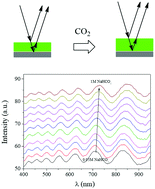A CO2-responsive hydrogel film for optical sensing of dissolved CO2†
Abstract
CO2-monitoring plays an important role in medicine, environmental sciences, and food industries. Here, a new CO2-responsive hydrogel film was fabricated from branched polyethyleneimine (BPEI) and partially oxidized dextran (PO-Dex) via layer-by-layer (LBL) assembly, based on the in situ Schiff base reaction between the two polymers. The swelling behaviours of the films were studied using Fabry–Perot fringes on their reflection spectra. Like ordinary hydrogels, the BPEI/PO-Dex films swell in water. In addition, they swell to a larger degree when CO2 is introduced, due to the reaction between CO2 and the amino groups in BPEI. The CO2-induced swelling can be reported by the shift of the Fabry–Perot fringes on their reflection spectra; therefore, the BPEI/PO-Dex film can be used as an optical sensor for dissolved CO2. In the new sensor, the BPEI/PO-Dex film acts as a CO2-sensing material and Fabry–Perot cavity simultaneously. The introduction of ordered structure is no longer required. The response of the sensor to CO2 is linear and reversible. Unlike other hydrogel-based sensors that suffer from a slow response, the new sensor can respond to CO2 quickly, making it applicable for real-time, continuous monitoring of CO2 levels in solution.



 Please wait while we load your content...
Please wait while we load your content...